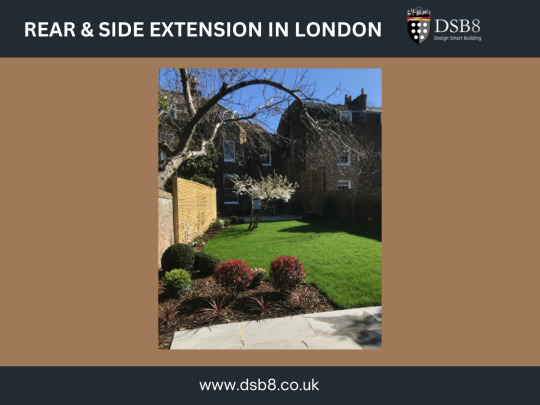Text
Budgeting and Financing Your Rear Extension Project in London

When contemplating an extension to your home in London, understanding the budget and financing aspects is crucial. Whether creating more space, adding value to your property, or simply enhancing your living environment, a well-planned budget is the foundation of a successful extension project. This comprehensive guide will explore the costs associated with different types of Rear extensions in london and the factors that influence these costs.
How Much Does a House Extension Cost?
The cost of a house extension in London can vary significantly based on many factors, including the type of extension, the materials used, the size, and the contractor you choose. However, to give you a starting point, here's an overview of the costs associated with different house extensions Interior Painting in London .
Ground Floor Rear House Extension Cost
Ground-floor rear extensions are a popular choice among London homeowners. They are ideal for expanding the kitchen or adding a dining area. The cost for this type of extension typically ranges from £1,500 to £2,300 per square meter. For a standard 20-square-meter extension, budget around £30,000 to £46,000.
Ground Floor Side Return House Extension Cost
Side return extensions in london are common in Victorian and Edwardian terraced houses in London. They fill in the narrow alley next to the kitchen to create a larger, more functional space. Depending on the complexity and finishes, these extensions cost from £2,000 to £2,500 per square meter.
Ground Floor Wraparound House Extension Cost
Combining both rear and side return extensions, the wraparound extension offers substantial additional space and can completely transform the ground floor of your home. The wraparound extensions cost about £2,000 per square meter but can increase significantly with high-end finishes and complex designs.
Whole-House Basement Extension
Creating a new basement or extending an existing one is an expensive but valuable investment, especially in London, where space is at a premium. Expect to pay between £3,000 and £4,000 per square meter, with costs soaring depending on depth and whether underpinning is necessary.
Glass Extension Cost
Glass extensions are an aesthetically pleasing option that can bring a modern touch to any home. They allow natural light to flood the space. Depending on the engineering and architectural requirements, these typically cost between £3,000 and £4,000 per square meter.
Conservatories and Orangeries Cost
Conservatories and orangeries are cost-effective ways to add light and space to your home. The cost of conservatories starts at around £1,000 per square meter, while orangeries are slightly higher at about £2,000 per square meter, reflecting their more substantial construction.
Flat Pack Extension Costs
Flat pack extensions, also known as modular extensions, are pre-fabricated off-site and assembled on-site, potentially saving time and money. Prices range from £1,500 to £2,500 per square meter.
Semi-Detached House Extension Costs
Extending a semi-detached house typically involves either a rear or side return extension or sometimes both. Costs generally start at around £1,500 per square meter but vary widely based on design choices and local planning requirements.
Additional House Extension Costs
Remember to budget for additional costs such as architectural designs, planning permissions, building regulations, and interior finishes. These can add 10-20% to the project's overall cost.
What Affects the Overall House Extension Cost?
Several factors can influence the cost of your house extension project:
Design and Planning
The complexity of the design and the architect's fees can have a significant impact. Custom designs with high-end finishes will increase costs.
Extension Size, Shape, and Height
Larger, more complex extensions will cost more. Height can also be a factor, especially if it involves altering the roof line.
Building Site Constraints
Site access, ground conditions, and proximity to neighbouring properties affect construction costs.
Windows and Doors
The size and quality of windows and doors can significantly affect the extension's cost and appearance.
Construction
The choice of materials and the construction method will impact the overall budget. High-quality materials and specialized labour are more costly but can provide a better finish and durability.
Conclusion
Planning and budgeting for a house extension in London requires carefully considering various factors contributing to the overall cost. By understanding these elements and planning accordingly, you can ensure that your extension project meets your needs and stays within your budget. Whether you opt for a modest glass extension or a full-scale basement project, the key to a successful extension is in the planning and execution.
FAQ
What is the average cost of a ground floor rear extension in London?
Answer: The average cost for a ground floor rear extension in London typically ranges between £1,500 to £2,300 per square meter. For a standard extension of about 20 square meters, the overall cost can vary from approximately £30,000 to £46,000, depending on the specifications and finishes chosen.
How does the size and shape of the extension affect the overall cost?
Answer: The size and shape of the extension significantly impact the total cost. Larger and more complex shapes require more materials and labor, which increases the expenses. Additionally, unconventional shapes might require custom solutions for construction and design, further elevating the cost.
Are there any additional costs I should consider when budgeting for a house extension?
Answer: Yes, besides the basic construction costs, you should account for additional expenses such as architectural design fees, planning permissions, building regulations, and interior finishes. These can add an extra 10-20% to your overall budget. It's also wise to set aside a contingency fund for unexpected costs during the project.
What are the cost differences between conservatories and orangeries?
Answer: Conservatories are generally less expensive than orangeries, with costs starting around £1,000 per square meter for conservatories and about £2,000 per square meter for orangeries. The higher cost of orangeries reflects their more robust construction and the use of more substantial materials, which typically results in better insulation and durability.
How can I reduce the cost of my house extension project without compromising quality?
Answer: To reduce costs effectively while maintaining quality, consider simpler designs and standard materials that are easy to work with and readily available. Additionally, sourcing multiple quotes from contractors can help you find the best value. Planning the project during off-peak seasons might also reduce costs, as contractors are often willing to negotiate during less busy periods.
#house refurbishment london#house refurbishment in london#interiors#home refurbishments london#loft conversions#london loft conversion company#loft conversion specialists london#loft extension london#loft conversion london#contemporary rear extensions london#Rear extensions in london#house extension
0 notes
Text

0 notes
Text
What are the rules for a Loft Conversion?

In-home improvement loft conversions are one of the most popular and rewarding projects. Homeowners who want to increase their living space and add value to their property can benefit from our services. However, amidst the excitement of transforming the underutilized attic space into a fashionable and practical living area, it's crucial to understand the rules and regulations governing such endeavours. This comprehensive guide will delve into the essential rules for a loft conversion london, explore the various types available, and provide insight into the associated costs.
Understanding the Rules for a Loft Conversion
It is crucial to familiarize oneself with local authorities' regulations before starting a loft conversion project, as these can vary based on location. Several fundamental considerations typically apply:
Permitted Development Rights: Loft conversion company Lodon often fall within permitted development rights, meaning you can proceed without planning permission. However, there are limits regarding the size, height, and placement of the conversion, so it's essential to consult with your local planning department to ensure compliance.
Building Regulations: Regardless of whether planning permission has been granted or not, "required, loft conversions must adhere to building regulations. These regulations cover structural stability, fire safety, insulation, ventilation, and other essential aspects to ensure the safety and habitability of the space.
Party Wall Agreements: If your property is adjacent to another property and shares a wall with it, you may need to take certain measures or precautions. Before commencing work on your loft conversion, obtain a party wall agreement. This agreement ensures that any structural alterations do not adversely affect the neighbouring property and outlines the responsibilities of both parties.
Conservation Areas and Listed Buildings: Properties located in conservation areas or listed buildings may be subject to additional planning restrictions to preserve their historic or architectural significance. To navigate these regulations successfully, it's essential to consult with local authorities and heritage conservation bodies.
Adhering to these rules and regulations ensures that your loft conversion project proceeds smoothly and complies with legal requirements, avoiding potential setbacks and complications.
Real Architects = Real Loft Conversion Costs
One of the primary concerns for homeowners considering a loft conversion is the associated costs. While it's tempting to opt for the cheapest quote, cutting corners on design and construction can lead to subpar results and, ultimately, costlier repairs down the line. Investing in the expertise of a qualified architect or architectural designer can make all the difference in achieving a successful and high-quality loft conversion.
Architects bring valuable skills and knowledge to the table, including:
Design Expertise: Architects have the creative vision and technical know-how to maximize the potential of your loft space, optimizing layout, functionality, and aesthetics to suit your needs and preferences.
Regulatory Compliance: Architects are well-versed in building regulations and planning requirements, ensuring that your loft conversion meets all necessary standards and avoids costly mistakes.
Project Management: From initial concept to final construction, architects oversee every stage of the loft conversion process, coordinating with contractors, suppliers, and authorities to ensure smooth progress and timely completion.
Quality Assurance: Working with reputable architects will ensure superior craftsmanship, attention to detail, and overall quality in the execution of your loft conversion project.
While enlisting the services of a professional architect may entail higher upfront costs, the long-term benefits in terms of quality, functionality, and resale value far outweigh the initial investment.
The Different Types of Loft Conversions
Loft conversions come in various forms, each offering unique advantages and considerations. Here are some of the most common types:
Dormer Loft Conversion: A dormer extension involves adding a box-like structure to the existing roof, creating additional headroom and floor space. Dormers are versatile and can be tailored to suit different architectural styles and preferences.
Hip-to-Gable Conversion: This type of conversion involves extending the hip roof to create a vertical gable end, thereby maximizing internal space and allowing for larger windows or dormers. Hip-to-gable conversions are ideal for properties with hipped roofs.
Mansard Loft Conversion: Named after the French architect François Mansart, this conversion features a steeply sloping roof with a flat top and vertical walls. Mansard conversions provide ample headroom and floor space, making them famous for creating full-floor living areas.
Roofline Loft Conversion: Also known as a Velux or skylight conversion, this option utilizes roof windows or skylights to introduce natural light and ventilation into the loft space. Roofline conversions are relatively cost-effective and are well-suited to properties with sufficient roof height.
L Section Conversion: In this configuration, the loft space is extended over a property section, typically at the rear or side. L section conversions can accommodate various layouts and design features, making them adaptable to different property layouts.
Custom Conversion: For homeowners with specific requirements or design preferences, a custom loft conversion offers the flexibility to tailor every aspect of the project to suit individual needs. From layout and materials to finishing touches, custom conversions provide a bespoke solution for maximizing space and functionality.
Each type of loft conversion presents its own set of opportunities and challenges, so it's essential to carefully consider your objectives, budget, and property constraints when selecting the most suitable option.
Guide Costs For Common Types Of Loft Conversions
While the costs of loft conversions can vary widely depending on factors such as size, complexity, location, and materials, here's a rough guide to the typical costs associated with common types of loft conversions:
Dormer Loft Conversion: £20,000 - £45,000
Hip To Gable Conversion: £25,000 - £50,000
Mansard Loft Conversion: £35,000 - £60,000
Roofline Loft Conversion: £15,000 - £30,000
L Section Conversion: £20,000 - £40,000
Custom Conversion: £30,000 - £70,000+
It's important to note that these figures are estimates and can vary significantly depending on various factors, such as the conversion size, the quality of materials and finishes, and the property's location. Additional expenses such as planning fees, building regulations, structural alterations, and professional fees may influence the project's overall cost. When budgeting for a loft conversion, it is advisable to obtain quotes from multiple contractors and architects, considering the scope of the work and any potential hidden costs. By planning and budgeting carefully, you can ensure that your loft conversion project stays within budget while delivering the desired results.
Conclusion
Loft conversions offer a fantastic opportunity to unlock your home's hidden potential, providing valuable additional living space and enhancing its overall appeal and functionality. By understanding the rules and regulations governing loft conversions, investing in the expertise of real architects, and exploring the various types and costs involved, you can confidently start your loft conversion project. Knowing that you're making a sound investment in your property's future.
FAQ
Do I need planning permission for a loft conversion?
In many cases, loft conversions can be carried out under permitted development rights, meaning planning permission isn't required. However, there are limits regarding size, height, and placement. It's advisable to consult with local planning authorities to ensure compliance.
How long does a loft conversion typically take to complete?
The duration of a loft conversion project depends on various factors, including the type and complexity of the conversion, the size of the space, and any unforeseen challenges encountered during construction. On average, a loft conversion can take anywhere from 6 to 12 weeks to complete.
Will I need to hire an architect for my loft conversion project?
While it's not mandatory to hire an architect, their expertise can be invaluable in optimizing the design, ensuring compliance with building regulations, and overseeing the construction process. Architects bring creativity, technical knowledge, and project management skills to the table, ultimately enhancing the quality and success of your loft conversion.
How much does a loft conversion cost?
The cost of a loft conversion varies depending on factors such as the type of conversion, the size of the space, the quality of materials and finishes, and the location of the property. As a rough guide, prices can range from £15,000 to £70,000 or more. It's recommended to obtain quotes from multiple contractors and architects to get an accurate estimate for your specific project.
What are the main benefits of a loft conversion?
Loft conversions offer numerous benefits, including:
Maximizing underutilized space: Transforming an attic into a functional living area adds valuable square footage to your home.
Adding value to your property: A well-executed loft conversion can significantly increase the resale value of your home.
Creating versatile living space: Whether it's an additional bedroom, home office, gym, or entertainment area, loft conversions provide flexibility to meet your lifestyle needs.
Enhancing natural light and ventilation: With the addition of windows, skylights, or dormers, loft conversions can introduce abundant natural light and fresh air into your home, improving comfort and wellbeing.
0 notes
Text
0 notes
Text
Narrow Side Return Extensions in London: Creative Solutions for Small Spaces
In the bustling urban landscape of London, space is a premium commodity. Homeowners and developers constantly seek innovative ways to maximize their property's potential. Narrow-side return extensions offer a splendid solution to this difficulty, particularly in areas like Chelsea, where traditional expansion options may be limited. This blog explores the transformative impact of side house extensions in London, emphasizing rear home extensions, house refurbishment, and creative interior solutions such as micro cement flooring.
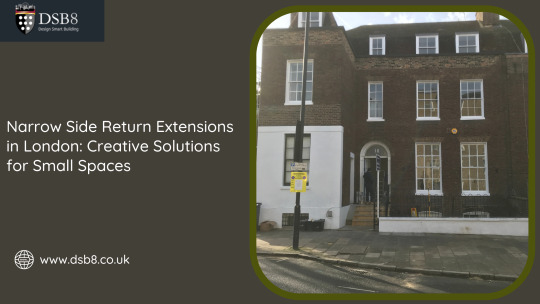
1. Understanding Narrow Side Return Extensions
A narrow side return extension typically fills the unused space at the side of terraced or semi-detached homes, turning it into a valuable part of the living area. This type of extension is prevalent in London due to the structure of many homes and the restricted urban space. By choosing a proficient Building Company, Chelsea, homeowners can ensure that even the smallest space is optimized creatively and efficiently.
2. Benefits of Side House Extensions in London
Expanding your home with a side extension can dramatically increase your living space without the need to relocate. Here are several advantages:
Enhanced Functional Space: Perfect for kitchens, dining rooms, or utility rooms.
Increased Property Value: Extending your home can significantly boost its market value, especially when done by a reputable London Loft Conversion Company.
Improved Natural Light: With the right design, side returns can enhance light in your home, making it appear larger and more welcoming.
3. Popular Design Features in Side Return Extensions
When planning your extension, consider incorporating features that not only enhance space but also add to its aesthetic and functional appeal:
Skylights and Transparent Doorways: Designed to optimize the influx of daylight into your home.
Microcement Flooring: This versatile and stylish option complements modern decor and is provided by specialists in microcement flooring in London.
Bespoke Storage Solutions: Custom cabinets and shelves can help utilize every inch of your new extension.
4. Key Considerations When Planning Your Extension
Before embarking on your extension project, consider the following to ensure a smooth process:
Permissions and Regulations: Understand the local building regulations and obtain the necessary permissions.
Choosing the Right Builder: Select a building company in Chelsea known for quality and reliability.
Budget Management: Keep track of your finances to avoid overspending.
5. Transforming Spaces with Innovative Materials and Designs
Modern materials like micro cement are durable and sleek, ideal for contemporary extensions. A London Loft Conversion Company can also suggest innovative ways to integrate lofts with side extensions for additional space.
Conclusion
Narrow-side return extensions are brilliant for London homeowners looking to expand their living space. With careful planning and creative design, these extensions can transform a cramped area into a beautiful and functional part of your home. Choosing the right professionals, from designers to builders, will ensure your home extension succeeds.
FAQs Related to Narrow Side Return Extensions
Q. What are the typical costs associated with a narrow-side return extension in London?
A. The costs vary widely based on materials, size, and the Building Company Chelsea you choose. It's best to get several quotes and have detailed consultations.
Q. How long does it take to complete a side house extension in London?
A. Depending on the complexity and scale, it could take 12 weeks to several months. Consult with your London Loft Conversion Company or builder for a realistic timeline.
Q. Do I need planning permission for a side return extension in London?
A. Only sometimes, as some extensions fall under permitted development rights, is it crucial to check with your local council or a professional house refurbishment London company.
Q. Can microcement flooring be customized to match my home decor?
A. Yes, micro cement flooring in London offers a diverse selection of colours and textures that can be customized to match your home's aesthetic.
Q. What are the best ways to ensure that my extension is environmentally friendly?
A. Discuss sustainable building materials and energy-efficient designs with your Building Company, Chelsea, to minimize environmental impact.
#contemporary rear extensions london#narrow side return extension london#rear extensions london#rear home extensions london#side house extensions london#microcement london#Side Return Extension london#house refurbishment london#microcement flooring london#loft extension london#wallpapering london#micro cement company#london loft conversions#wallpaper hangers london#london loft conversion company#wallpaper installation london#loft conversion specialists london#loft conversion london#professional wallpaper installers london#wallpaper hanging london#home refurbishments london#decorator wallpaper
0 notes
Text

Craft your dream sanctuary with our luxury bedroom construction design services in London. From timeless elegance to contemporary chic, we tailor every detail to reflect your style and aspirations. Experience unparalleled comfort and sophistication as we bring your vision to life, ensuring a bedroom that embodies opulence and tranquility.
#loft conversion london#loft conversion specialists london#london loft conversion company#london loft conversions#loft extension london#rear extensions london#rear home extensions london#contemporary rear extensions london#Side Return Extension london#narrow side return extension london#side house extensions london#house refurbishment london#bathroom refurbishment london#sash windows refurbishment london#home refurbishments london#property refurbishments london#refurbishment company in london
0 notes
Text
The Cost of Loft Conversion in London: Budgeting and Financing Options
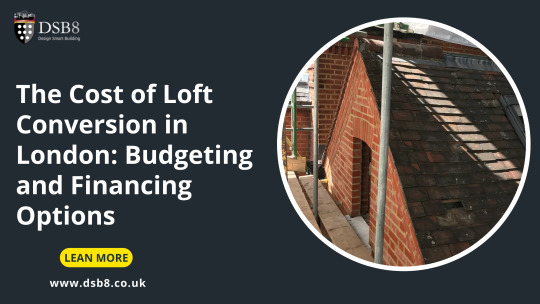
Introduction:
Loft conversions have become increasingly popular in London due to the city's ever-rising property prices and limited space. Converting an unutilized attic space into a practical living area." adds value to your property and provides much-needed extra space without the hassle of moving. However, before embarking on this exciting renovation journey, it's crucial to understand the costs involved, budget effectively, and explore financing options to make your loft conversion project a reality.
How much does a loft conversion cost?
The cost of a loft conversion may vary depending on different factors, such as the item's size." loft, the type of conversion, the level of finish, and your location. A basic loft conversion in London can average around £20,000 to £50,000 or more for more extensive, high-spec conversions. Obtaining quotes from reputable builders or loft conversion specialists is essential to get a precise estimate tailored to your requirements.
Looking to Find Out More About Loft Conversion Costs?
If you're keen to delve deeper into loft conversion costs, it's advisable to research extensively and gather quotes from multiple sources. Websites, forums, and online calculators can provide valuable insights into typical expenses and help you gauge the feasibility of your project within your budget constraints.
How Much is a Loft Conversion?
The cost of a loft conversion can vary depending on various factors, including the project's size and complexity, the materials used, and the level of finishing. A basic loft conversion typically includes insulation, flooring, stairs, windows, and electrics. In contrast, higher-end conversions may include additional features such as en-suite bathrooms, bespoke storage solutions, and premium finishes.
How Much Does a Loft Conversion Cost in London?
London is known for its higher-than-average property prices and construction costs, making loft conversions in the capital more expensive than other regions in the UK. While the average cost of a loft conversion in London may be higher, the potential increase in property value and the additional living space can make it a worthwhile investment in the long run.
How Can I Finance My Loft Conversion?
Financing a loft conversion can be achieved. Different methods to manage your finances vary depending on your financial situation and personal preferences. Some standard financing options include:
Savings:
If you have sufficient savings, funding your loft conversion project from your pocket can be cost-effective, eliminating the need for interest payments or loan repayments.
Home Equity:
If you have built up equity in your property, you can borrow against it through a home equity loan or line of credit. This can provide the necessary funds to finance your loft conversion while leveraging the value of your home.
Personal Loan:
Another option for financing your loft conversion is to take out a loan from a bank or lending institution. Personal loans usually have a set interest rate and repayment period, which can help you plan and manage your finances effectively for the project.
Remortgaging:
If you have sufficient equity in your property, remortgaging to release funds for your loft conversion may be a viable option. However, it's essential to consider the long-term implications and seek professional financial advice before proceeding.
Types of Loft Conversions and Guide to Loft Conversion Prices:
There are several loft conversions, each with unique features and cost considerations. The most common types include:
Roof Light Conversion:
Also known as a Velux conversion, this is the simplest and most cost-effective option, involving the installation of roof windows to create a bright, airy living space. Prices for roof light conversions typically start from around £20,000.
Dormer Conversion:
A dormer conversion involves extending the existing roof to create additional headroom and floor space, typically at the rear of the property. Prices for dormer conversions vary depending on the size and complexity but generally start from £30,000 upwards.
Hip to Gable Conversion:
This conversion involves extending the hip roof to create a gable end, providing additional internal space and headroom. Prices for hip-to-gable conversions typically start from £40,000 onwards.
Mansard Conversion:
A Mansard conversion involves extending the roof on one or both sides of the property to create a flat roof with sloping walls. This type of conversion often provides the most significant increase in floor space and can be more expensive, with prices starting from £50,000 or more.
Conclusion:
Embarking on a loft conversion project in London requires careful planning, budgeting, and consideration of financing options to ensure its success. By understanding the costs involved, exploring different financing avenues, and selecting the correct type of conversion for your property, you can transform your attic space into a valuable asset that enhances your living environment and property value. With proper research and professional guidance, the dream of a stylish and functional loft conversion in London can become a reality.
0 notes
Text
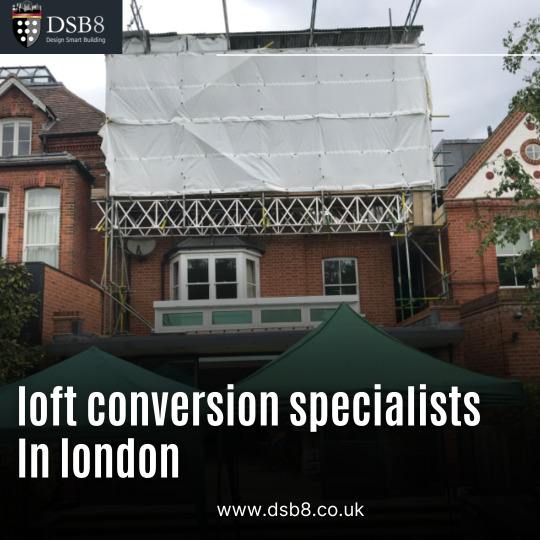
loft conversion specialists In london
0 notes
Text
Top Trends in London Loft Conversions: Maximizing Space and Value
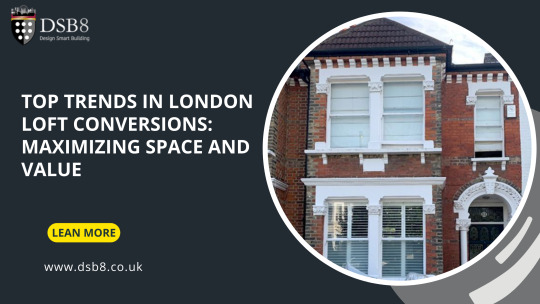
Introduction
London's real estate market is renowned for its high demand and limited space. It makes loft conversions increasingly popular for homeowners seeking to unleash additional space and increase property value. This blog post will explore the top trends in London loft conversions, focusing on maximizing space and value. We'll delve into critical factors that define the best loft conversions in London, from building regulations to design trends and sustainable materials.
Unlocking Space and Value: Exploring the Best Loft Conversions in London
Building Regulations
Before embarking on any loft conversion project, it's essential to be well-versed in the building regulations that apply in London. Complying with local building codes during the conversion process is critical to meet safety and quality standards. Hiring a professional architect or contractor understanding these regulations is crucial to a successful loft conversion.
Purpose of the Loft Conversion
The purpose of your loft conversion can significantly influence its design and layout. Whether you're looking to create an additional bedroom, a home office, a guest suite, or a recreational area, clarifying your objectives early in the planning process is essential. Each purpose will have its own set of design requirements and considerations.
Design and Style
The design and style of your loft conversion play a significant role in maximizing space and value. Consider your home's existence and how the new space will seamlessly blend with design styles for London loft conversions, including contemporary, industrial, minimalist, and traditional, each offering a unique charm and appeal.
Top Design Trends for the Best Loft Conversions in London
Sustainable Materials
Sustainability is a growing concern in today's construction industry, and loft conversions in London are no exception. Using sustainable building materials and energy-efficient features benefits the environment and increases your property's value. Consider options like reclaimed wood, energy-efficient windows, and eco-friendly insulation.
Multi-Functional Spaces
Maximizing space in a loft conversion is all about versatility. Maximize your space with multi-functional furniture, such as built-in storage units, fold-down desks, and convertible pieces. This flexibility enhances usability and convenience while increasing your property's value.
Smart Technology
Incorporating innovative technology into your loft conversion can add a touch of modernity and convenience. From endless possibilities, from mated lighting and climate control to integrated sound systems and security features, this technology enhances your daily living experience and attracts potential buyers, increasing property value.
Statement Lighting
Proper lighting is essential to create the right atmosphere in your loft conversion. Eye-catching light fixtures like chandeliers, pendant lights, and unique lamps can offer ample illumination and become the room's focal point. Well-placed and stylish lighting enhances the overall aesthetics and functionality of the space.
Conclusion
London loft conversions have become a popular means of unlocking additional space and increasing property value in a city where every square foot counts. By understanding and adhering to building regulations, defining the purpose of your loft conversion, and incorporating design trends such as sustainable materials, multi-functional spaces, innovative technology, and statement lighting, you can create a space that not only maximizes space but also adds significant value to your home. Remember these trends as you embark on your loft conversion journey in London dynamic real estate market.
0 notes
Text
The Ultimate Guide to Loft Conversion in London: A Step-by-Step Process
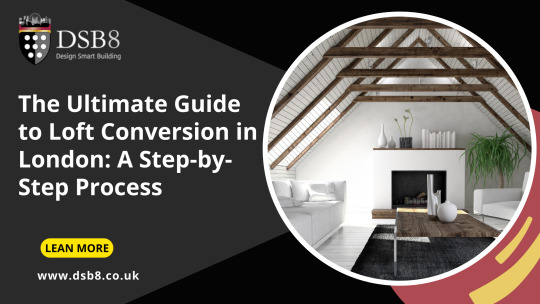
Introduction
In a city like London, where space comes at a premium, many homeowners turn to loft conversions as a practical solution to expand their living space. Whether you need an extra bedroom, a home office, or a recreational area, converting your loft can be a cost-effective and space-efficient way to meet your needs. In this comprehensive guide, we will take you through the entire loft conversion process in London, step by step. We've got you covered, from understanding why loft conversions are a wise choice to budgeting for your project.
The Ultimate Guide to Loft Conversions
Why Consider a Loft Conversion?
Maximizing Your Existing Space: One of the most compelling reasons to consider a loft conversion is to make the most of the space you already have. London properties often have limited square footage, and utilizing the often-neglected loft can significantly increase your usable living area without extending your property's footprint.
Cost-Effective Expansion: Unlike moving to a larger house or building an extension, loft conversions are a more cost-effective way to add space to your home. You don't need to acquire additional land or go through the hassle of selling and buying a new property.
Added Property Value: Loft conversions can substantially increase the value of your home. In London's competitive property market, having an additional bedroom or living space can improve your property. Making specific changes can enhance the product's attractiveness. "This could result in a higher value to potential buyers."\ selling price. Resale value.
Avoiding Planning Permission Hassles: In many cases, loft conversions fall under Permitted Development Rights (PD), which means you may not need planning permission, saving you time and money. However, checking with your local planning authority to confirm your eligibility for PD rights is essential.
Energy Efficiency: Properly insulated loft conversions can improve your home's energy efficiency. Upgrading your loft's insulation and installing energy-efficient windows Using insulation can decrease the amount of heat that is lost and ultimately lower your energy bills.
Cost and Budgeting for a Loft Conversion
"Now that you clearly understand the advantages of a loft conversion, Let's delve into the cost and budgeting aspects of this exciting home improvement project.
Initial Assessment: The first step in budgeting for a loft conversion is to assess your loft's suitability and condition. A structural engineer or architect can help you determine if your attic can be converted and provide you with an estimate of the costs involved.
Design and Planning: You'll need detailed architectural plans once you proceed with the project. Hiring an architect or designer will add to your overall cost but is crucial for obtaining accurate quotes from builders and ensuring your loft conversion meets building regulations.
Building Regulations and Permissions: While loft conversions often fall under Permitted Development Rights, you may still need to comply with building regulations. Factor in costs for building control inspections, structural calculations, and any necessary planning permissions.
Builder's Quote: Obtaining quotes from reputable builders or loft conversion specialists is essential for budgeting accurately. Get at least three quotes to compare prices. Please remember to check references to ensure the quality of the work.
Structural Work: The structural work in converting a loft includes reinforcing the floor, adding roof supports, and installing access points like stairs or ladders. This is a significant portion of the budget, so be prepared for these costs.
Interior Finishes: Consider the interior finishes you want for your loft, including flooring, insulation, plastering, and electrical and plumbing work. High-quality finishes will increase your budget, but they are essential for a comfortable and visually appealing space.
Fixtures and Fittings: Budget for fixtures such as windows, doors, skylights, and any built-in storage or furniture you plan to include in your loft conversion. These items can vary widely in price depending on their quality and design.
Contingency Fund: Always set aside a contingency fund for unforeseen expenses or changes in the project. A common rule of thumb is to allocate around 10% of your budget for contingencies.
VAT and Professional Fees: Don't forget to account for value-added tax (VAT) on materials and labour, as well as professional fees for architects, engineers, and surveyors.
Project Timeline: Keep in mind that the longer the project takes, the more it will cost in terms of labour and temporary accommodations if necessary. Set a realistic project timeline and budget for potential delays.
Financing Options: Consider how you will finance your loft conversion. Options include personal savings, home equity loans, or remortgage. Choose the financing method that aligns with your financial situation and goals.
Cost-Saving Strategies: To stay within your budget, explore cost-saving strategies like using reclaimed materials, negotiating with suppliers, or doing some of the work yourself if you have the skills.
Conclusion
A loft conversion in London can be a fantastic way to add space, value, and functionality to your home. By understanding why loft conversions are a practical choice and carefully budgeting for your project, you can confidently embark on this journey. Plan thoroughly, consult experts, and prepare for unexpected challenges. With the right approach and resources, you can transform your loft into a beautiful, functional living space that enhances your London home's appeal and value.
0 notes
Text
1 note
·
View note

